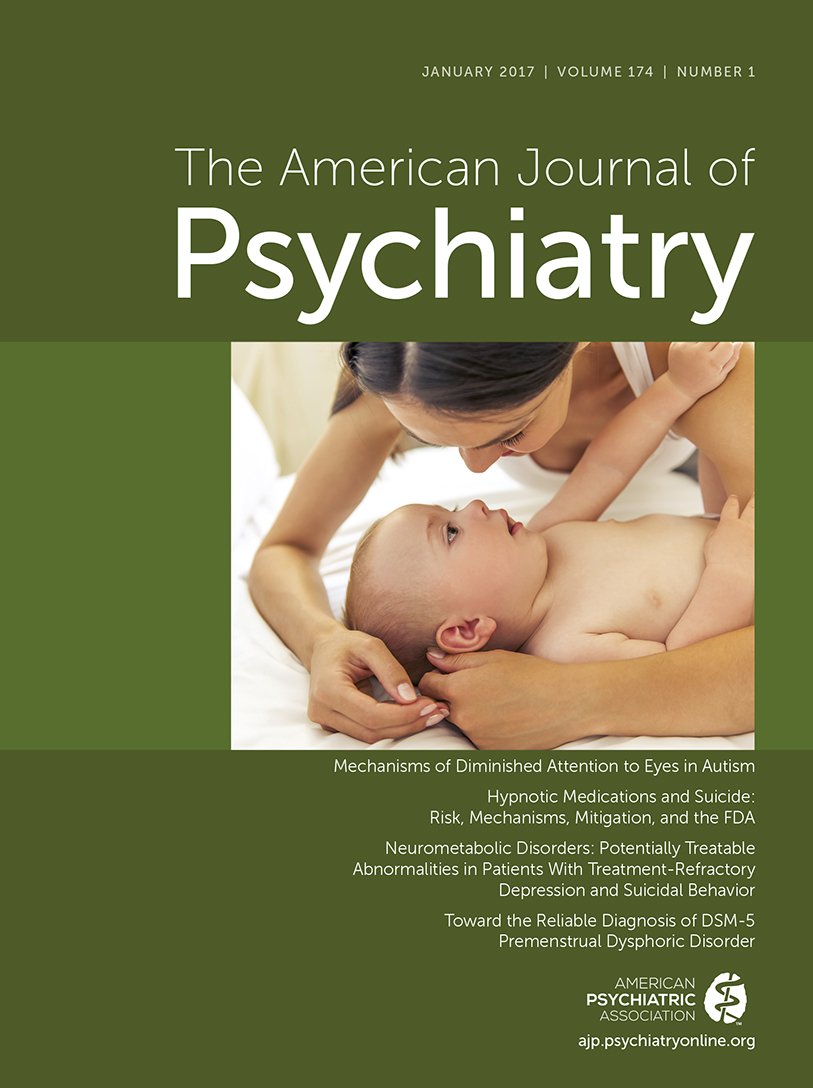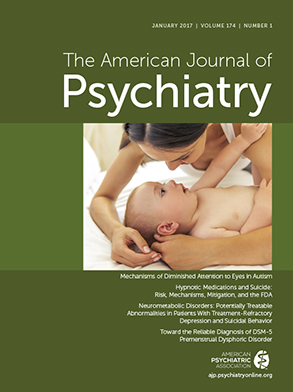Premenstrual dysphoric disorder (PMDD) is a cyclic mood disorder that affects up to 8% of women worldwide (
1,
2). To meet DSM-5 criteria for PMDD, a woman must experience at least five of 11 cognitive-affective, behavioral, and physical symptoms, at least one of which must be a key mood symptom (irritability, affective lability, depressed mood, anxiety/tension). Symptoms must be present during the final week of the premenstrual (luteal) phase, remit “within a few days” after menses onset, and “become minimal or absent in the week postmenses,” i.e., the follicular phase. This constellation of symptoms must have occurred in most menstrual cycles in the previous year and must be confirmed with at least two cycles of prospective daily ratings. Symptoms must result in clinically meaningful distress or impairment, cannot represent a mere exacerbation of symptoms of another disorder, and cannot be induced by the use of steroid contraceptives (
3,
4). While inclusion of PMDD as a full disorder in DSM-5 was certainly a major step forward for women who suffer from it, further efforts are needed to systematize the application of the disorder’s diagnostic criteria in clinical and research settings (
5).
One of the primary challenges in the differential diagnosis of PMDD is the distinction between women who meet the full DSM-5 criteria and those who experience clinically meaningful premenstrual mood symptoms but fall short of the five-symptom or severity thresholds. This latter group may have another menstrually related mood disorder (MRMD), such as premenstrual worsening of an affective disorder or subthreshold PMDD (
3), and be as distressed or impaired as someone with full-criteria PMDD (
6). However, inclusion of these individuals in research focusing on the pathophysiology and treatment of PMDD hinders scientific advancement. Moreover, treatment during the luteal phase or at symptom onset with selective serotonin reuptake inhibitors, which have shown effectiveness in the treatment of PMDD, may not be appropriate for individuals with other MRMDs (
7,
8).
Eisenlohr-Moul and colleagues (
9) have made significant strides in the effort to standardize and simplify the application of the DSM-5 criteria to the assessment of women with MRMDs with the development of the Carolina Premenstrual Assessment Scoring System (C-PASS). As noted by Eisenlohr-Moul et al. in this issue, the DSM-5 criteria for PMDD encompass several dimensions:
content (presence of specific symptoms),
cyclicity (symptoms present only in the premenstruum),
severity (clinically significant distress or impairment), and
chronicity (relative occurrence of symptoms in the past year). The latitude for interpretation in these dimensions is considerable, creating the potential for inconsistency in diagnosis in both the clinical and research settings. While much of the research focusing on PMDD conforms to the requirement that symptoms be present during some portion of the week prior to menses and absent during the postmenstrual week, there is no standard for the number and range of days used to define each phase, nor for the degree of increase in a premenstrual compared with postmenstrual symptom that qualifies it for consideration as one of the requisite five symptoms. Consistent operationalization would allow researchers to compare “apples to apples” in future PMDD and non-PMDD MRMD studies.
In the clinical setting, the process of making a diagnosis of PMDD is unlike that of any other affective disorder. Prospective daily ratings are required because retrospective reporting of symptoms has poor consistency with prospectively confirmed PMDD or expert clinician diagnosis (
1,
9). However, a daily rating instrument, such as the gold-standard Daily Record of Severity of Problems (DRSP) (
10), which serves as the basis for the C-PASS, contributes more than 1,000 data points when 2–3 months of daily ratings have been completed. Visual inspection of the ratings is not sufficient for diagnosis, yet calculation of premenstrual versus postmenstrual symptom severity is not practical in the primary care setting, where many women with MRMDs first present.
The C-PASS addresses a number of these weaknesses in the differential diagnosis of MRMDs. It provides a computerized (or paper and pencil, if preferred) daily rating system based on the DMS-5 criteria. The daily ratings are then calculated with a macro (in Excel or SAS) to distinguish those who meet full PMDD criteria from those with a non-PMDD MRMD diagnosis, or neither. Similar to the criteria put forth with the DRSP, the C-PASS requires, for the dimension of severity, that a symptom be scored at least a 4 (moderate, on a scale of 1 to 6) on at least 2 days in the premenstrual week and meet the remaining dimensional criteria (content, cyclicity, chronicity) to be considered as one of the five symptoms necessary for a PMDD diagnosis. For non-PMDD MRMD, only one symptom meeting these dimensional criteria is required.
Eisenlohr-Moul et al. tested the C-PASS’s diagnostic validity in a sample of 267 women with premenstrual mood complaints. To develop empirically based severity and time-frame parameters, the researchers applied the five most commonly used calculation methods for three levels of symptom elevation relative to baseline (30%, 50%, and 75%) to the women’s daily ratings. While the numerator was held consistent (premenstrual minus postmenstrual average score for each symptom), the denominator used for each symptom calculation varied by including those applied in previous PMDD research: 1) the individual’s average postmenstrual score, 2) average premenstrual score, 3) the range of scale used by that individual, 4) range of scale minus 1, or 5) a woman’s own standard deviation for a given symptom. Testing each of these methods for calculation produced PMDD prevalence rates ranging from 1% to 27% within the same sample of 200 women who completed at least 2 months of daily ratings. Of the five techniques, the 30% threshold range-of-scale calculation method yielded prevalences rate most similar to those expected for women reporting premenstrual mood complaints—19% for PMDD and 23% for non-PMDD MRMDs. Using this calculation method, the C-PASS exhibited 94.5% agreement with expert clinical diagnosis of MRMDs in this sample.
The C-PASS is significant in that it is a simple data collection and calculation tool both for patients and busy clinicians, and it may allow greater uptake, particularly in younger populations familiar with using electronic instruments. It also allows for more consistent diagnosis in research settings. The C-PASS directs focus to the critical postmenses “switch-off” of symptoms by assessing symptoms in a “perimenstrual frame”—the premenstrual week including day 1 of menstruation compared with the postmenstrual week (the week following menses offset, standardized in this study as days 4–10). Inclusion of day 1 in the premenstrual symptom calculation is relatively novel, but it is consistent with findings from community and clinical cohorts that women with PMDD report the first day of menstruation as being one of the most symptomatic (
2). The C-PASS establishes a 30% symptom increase threshold empirically based on agreement with expert clinical diagnosis. Importantly, it uses a range-of-scale method that accounts for interindividual variability in scoring (i.e., some women may score only in a narrow range, while others may use the full 1-to-6 range, as symptom severity is subjective). The question that remains is whether investigators studying PMDD will unanimously apply these criteria for the dimensional aspects of the DSM-5 criteria.
While the C-PASS has many strengths, it is a tool, and it does not negate the need for clinical assessment. The provider should make the final judgment of which symptoms fit a particular construct. For instance, the DSM-5 criterion B includes irritability or interpersonal conflict as one of the five required symptoms for PMDD diagnosis, but not both. However, it is arguable that these are not the same construct, as the affective state of even severe irritability does not necessarily lead to the behavioral symptom of interpersonal conflict, and vice versa. Furthermore, distress and impairment are important features to consider. Even if a woman denies impairment (e.g., in relationships or at work), she may experience clinically significant distress, which should be acknowledged in making her diagnosis and discussing treatment options. The C-PASS results should be interpreted in light of such clinical judgments.
In summary, the C-PASS has important clinical and research implications and represents a significant stride toward simplifying and standardizing the DSM-5 criteria to the clinical care and study of PMDD and non-PMDD MRMDs.

